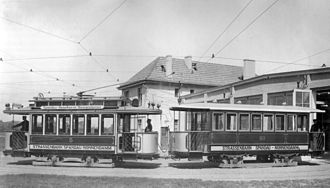Grenzstrasse depot
The depot Grenzstraße was as a depot , and later used as a vehicle depot system in today's Berlin district of Siemensstadt . The yard was built by Siemens & Halske to operate the Spandau – Nonnendamm electric tram - known as the “Nonnendammbahn” - and in 1918 it became the property of the city of Spandau . With the transition from the Spandau tram to the Berlin tram , the site changed hands again in 1920. Until the 1940s, the hall was used to park e-cars . After an air raid, the hall burned out in 1944.
Location and structure
The farm was located on Grenzstraße , which was closed in 1961, in the Siemensstadt district of the Spandau district . The street was laid out as a connection between Nonnendammallee and the street Am Schaltwerk . Coming from both sides of Nonnendammallee, a double-track stretch ran along the street to the hall, which in turn had six tracks. A two-storey administration and residential building was connected to the hall. To the west of the building was a turning loop that was put into operation in 1935 .
history
Siemens & Halske put a tram line into operation in September 1908 in order to develop the Siemens works, which were built on Nonnendamm in 1897 and have been known as Siemensstadt since 1914 . The wagons were initially stored in the railway hall on Rohrdamm, followed by the construction of the hall on Grenzstrasse from March to May 1909. It initially offered space for 18 cars and was fully sufficient for the Nonnendammbahn with its initially twelve cars. In 1909, the city of Spandau acquired the Nonnendammbahn, whose operation was taken over by the Spandau municipal tram the following year. The depot area, however, remained with Siemens, since the transfer of ownership of the area was simply overlooked. The Spandau tram relocated the railcars stationed here to the Pichelsdorfer Strasse depot . The sidecars stayed on Grenzstrasse. They were mainly used in rush hour traffic on line N ( Fürstenbrunn station - Spandau West station ) and on the amplifier line G (Fürstenbrunn station - Gartenfeld ). The first smaller expansion took place in 1912.
The transfer of the site to the city of Spandau was made up for in 1918, and two years later the city was incorporated into Berlin . Under the Berlin tram (BSt), which emerged in 1920, the yard was assigned the number 28a, which identified it as a branch of depot 28 on Pichelsdorfer Straße. In 1922/23, the BSt initiated another renovation in which the hall was lengthened by around 35 meters at both ends. The wagon capacity officially remained the same as the Berlin wagons had larger dimensions. Siemens and BSt shared the costs of the conversion; Siemens took over the construction of the hall, the BSt bore the costs for the reconstruction of the railway systems. After the expansion, it was possible to set up further lines from Siemensstadt towards Berlin city center and no longer just to Spandau. In the morning the lines drove to Siemensstadt with double-hung sidecars, where the trains were parked. The drivers then took other lines back to their home station and returned to the Grenzstraße in the afternoon to reoccupy the trains. The trains initially ended in front of the Siemens switchgear in Nonnendammallee, and in 1929 a turning loop went into operation next to the hall.
BVG , founded in 1929, used the hall to park trains until 1944, before it burned out after a bomb attack. Until it was dismantled in 1953, some wagons that were no longer needed were said to have been parked. The Wendeschleife served until December 1, 1954 as the terminus of line 35 (most recently Siemensstadt, Grenzstraße - Reinickendorf , Teichstraße) and then had to be closed for the expansion of Nonnendammallee. In 1961, Siemens bought the site back from the State of Berlin in order to be able to expand the switchgear. In the same year the foundations and inspection pits were removed. The dispatch building of the switching plant was then built on the site.
literature
- Arne Hengsbach: Grenzstraße tram station . In: Berliner Verkehrsblätter . Issue 12, 1976.
Individual evidence
- ↑ a b c d Arne Hengsbach: Grenzstraße tram station . In: Berliner Verkehrsblätter . Issue 12, 1976, pp. 243-245 .
- ↑ Hans-Jürgen Kämpf: The tram in Spandau and around Spandau . Ed .: Heimatkundliche Vereinigung Spandau 1954 eV Berlin 2008, ISBN 978-3-938648-05-6 , p. 248 .
- ↑ Marcel Götze: Post-War History 1950–1959. In: Berlin-Straba.de. Retrieved January 10, 2016 .
Coordinates: 52 ° 32 ′ 20 ″ N , 13 ° 15 ′ 15 ″ E

